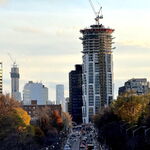The distance is 132.6 km so the average speed is 56 km/h for the weekend express train (which skips Hamilton Harbour), but yes we can do considerably better, even with additional stops in Stoney Creek and Grimsby.
Here's a fairly back-of-the-envelope for the following upgrades:
- USRC up to 45 mph (already under construction for Lakeshore platforms)
- Hamilton West Harbour - Stoney Creek Confederation: increase from 30 mph to 65 mph
- Stoney Creek - St Catharines: increase from 65 mph to 95 mph
- St Catharines - Niagara: increase from 65 mph to 75 mph; resolve slow zones in Niagara Falls.
View attachment 480525
So it looks like we could save about a half hour just by upgrading the CN Grimsby subdivision to the same standard as the existing GO-owned portion of the line. Additional savings are probably possible by further upgrading tracks between Hamilton and Toronto.
I'd also need to do a quick check on the scheduling. It's already possible to run hourly service with the existing track configuration but it might require a longer dwell in Hamilton to make the trains meet in the right spots.




